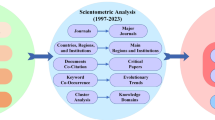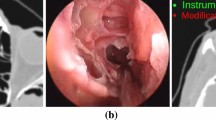Abstract
The emergence of steerable flexible instruments has widened the uptake of minimally invasive surgical techniques. In sinus surgery, such flexible instruments could enable the access to difficult-to-reach anatomical areas. However, design-oriented metrics, essential for the development of steerable flexible instruments for maxillary sinus surgery, are still lacking. This paper proposes a method to process measurements and provides the instrument designer with essential information to develop adapted flexible instruments for limited access surgery. This method was applied to maxillary sinus surgery and showed that an instrument with a diameter smaller than 2.4 mm can be used on more than 72.5% of the subjects’ set. Based on the statistical analysis and provided that this flexible instrument can bend up to \(164.4^\circ,\) it is estimated that all areas within the maxillary sinus could be reached through a regular antrostomy without resorting to extra incision or tissue removal in 94.9% of the population set. The presented method was partially validated by conducting cadaver experiments.








Similar content being viewed by others
References
Abd-alla, M. A., and A.-J. J. Mahdi. Maxillary sinus measurements in different age groups of human cadavers. Tikrit J. Dent. Sci. 3:107–112, 2014.
Albrecht, T., M. Luthi, and T. Vetter. A statistical deformation prior for non-rigid image and shape registration. In 2008 IEEE Conference on Computer Vision and Pattern Recognition, pp. 1–8, 2008.
Ariji, Y., E. Ariji, K. Yoshiura, and S. Kanda. Computed tomographic indices for maxillary sinus size in comparison with the sinus volume. Dentomaxillofac. Radiol. 25:19–24, 1996.
Chee, L., and D. Sethi. The endoscopic management of sinonasal inverted papillomas 1. Clin. Otolaryngol. Allied Sci. 24:61–66, 1999.
Coemert, S., R. Roth, G. Strauss, P. M. Schmitz, and T. C. Lueth. A handheld flexible manipulator system for frontal sinus surgery. Int. J. Comput. Assist. Radiol. Surg. 15:1549–1559, 2020.
Cootes, T. F., C. J. Taylor, D. H. Cooper, and J. Graham. Active shape models-their training and application. Comput. Vis. Image Understand. 61:38–59, 1995.
Danckaers, F., T. Huysmans, D. Lacko, A. Ledda, S. Verwulgent, S. Van Dongen, and J. Sijbers. Correspondence preserving elastic surface registration with shape model prior. In 2014 22nd International Conference on Pattern Recognition, pp. 2143–2148, 2014.
Dkhar, W., A. Pradhan, and M. Shajan. Measurement of different dimension of maxillary and frontal sinus through computed tomography. Online J. Health Allied Sci. 16:5, 2017.
Gafford, J., M. Freeman, L. Fichera, J. Noble, R. Labadie, and R. J. Webster, III. Eyes in ears: a miniature steerable digital endoscope for trans-nasal diagnosis of middle ear disease. Ann. Biomed. Eng., 2020. https://doi.org/10.1007/s10439-020-02518-9.
Giacomini, G., A. L. M. Pavan, J. M. C. Altemani, S. B. Duarte, C. M. C. B. Fortaleza, J. R. de Arruda Miranda, and D. R. De Pina. Computed tomography-based volumetric tool for standardized measurement of the maxillary sinus. PLoS ONE 13:e0190770, 2018.
Gosau, M., D. Rink, O. Driemel, and F. Draenert. Maxillary sinus anatomy: a cadaveric study with clinical implications. Anat. Rec. Adv. Integr. Anat. Evol. Biol. 292:352–354, 2009.
Heimann, T. and H.-P. Meinzer. Statistical shape models for 3d medical image segmentation: a review. Med. Image Anal. 13:543–563, 2009.
Hildenbrand, T., R. Weber, J. Mertens, B. A. Stuck, S. Hoch, and E. Giotakis. Surgery of inverted papilloma of the maxillary sinus via translacrimal approach—long-term outcome and literature review. J. Clin. Med. 8:1873, 2019.
Hong, W., L. Xie, J. Liu, Y. Sun, K. Li, and H. Wang. Development of a novel continuum robotic system for maxillary sinus surgery. IEEE/ASME Trans. Mechatron. 23:1226–1237, 2018.
Jun, B.-C., S.-W. Song, C.-S. Park, D.-H. Lee, K.-J. Cho, and J.-H. Cho. The analysis of maxillary sinus aeration according to aging process; volume assessment by 3-dimensional reconstruction by high-resolutional ct scanning. Otolaryngol. Head Neck Surg. 132:429–434, 2005.
Kamel, R. H. Conservative endoscopic surgery in inverted papilloma: preliminary report. Arch. Otolaryngol. Head Neck Surg. 118:649–653, 1992.
Karamert, R., F. Ileri, and A. Papavassiliou. Conventional and powered instrumentation for endoscopic sinus surgery. In All Around the Nose. Cham: Springer, pp. 675–682, 2020.
Kenned, D. W., S. J. Zinreich, F. Kuhn, H. Shaalan, R. Naclerio, and E. Loch. Endoscopic middle meatal antrostomy: theory, technique, and patency. Laryngoscope 97:1–9, 1987.
Keustermans, W., T. Huysmans, B. Schmelzer, J. Sijbers, and J. J. Dirckx. Matlab® toolbox for semi-automatic segmentation of the human nasal cavity based on active shape modeling. Comput. Biol. Med. 105:27–38, 2019.
Kiruba, L. N., C. Gupta, S. Kumar, A. S. D’Souza et al. A study of morphometric evaluation of the maxillary sinuses in normal subjects using computer tomography images. Arch. Med. Health Sci. 2:12, 2014.
Legrand, J., D. Dirckx, M. Durt, M. Ourak, J. Deprest, S. Ourselin, J. Qian, T. Vercauteren, and E. Vander Poorten. Active handheld flexible fetoscope–design and control based on a modified generalized prandtl-ishlinski model. In IEEE/ASME International Conference on Advanced Intelligent Mechatronics, 2020.
Noyes, W. S. Flexible-rigid hybrid endoscope and instrument attachments, 2019.
Rosen, J., L. N. Sekhar, D. Glozman, M. Miyasaka, J. Dosher, B. Dellon, K. S. Moe, A. Kim, L. J. Kim, T. Lendvay et al. Roboscope: A flexible and bendable surgical robot for single portal minimally invasive surgery. In 2017 IEEE International Conference on Robotics and Automation (ICRA), pp. 2364–2370, IEEE2017.
Sadeghi, N., S. Al-Dhahri, and J. J. Manoukian. Transnasal endoscopic medial maxillectomy for inverting papilloma. Laryngoscope 113:749–753, 2003.
Şahin, M. M., M. Yılmaz, R. Karamert, S. Cebeci, E. Uzunoğlu, M. Düzlü, and A. Ceylan. The evaluation of Caldwell–Luc operation in the endoscopic era; experience of the last 7 years. J. Oral Maxillofac. Surg. 78(9):1478–1483, 2020.
Sahlstrand-Johnson, P., M. Jannert, A. Strömbeck, and K. Abul-Kasim. Computed tomography measurements of different dimensions of maxillary and frontal sinuses. BMC Med. Imaging 11:8, 2011.
Schneider, J. S., J. Burgner, R. J. Webster III, and P. T. Russell III. Robotic surgery for the sinuses and skull base: What are the possibilities and what are the obstacles? Curr. Opin. Otolaryngol. Head Neck Surg. 21:11, 2013.
Sharma, S. K., M. Jehan, and A. Kumar. Measurements of maxillary sinus volume and dimensions by computed tomography scan for gender determination. J. Anat. Soc. India 63:36–42, 2014.
Sinha, A., S. Leonard, A. Reiter, M. Ishii, R. H. Taylor, and G. D. Hager. Automatic segmentation and statistical shape modeling of the paranasal sinuses to estimate natural variations. In Medical Imaging 2016: Image Processing 9784:97840D, 2016.
Souza, A. D., K. Rajagopal, V. H. Ankolekar, A. S. D. Souza, S. R. Kotian et al. Anatomy of maxillary sinus and its ostium: a radiological study using computed tomography. CHRISMED J. Health Res. 3:37, 2016.
Storz, K. Endoscopes and instruments for ENT esophagoscopy–bronchoscopy. https://www.karlstorz.com/cps/rde/xbcr/karlstorz_assets/ASSETS/3331528.pdf. Accessed 16 March 2020.
Tichenor, W. S., A. Adinoff, B. Smart, and D. L. Hamilos. Nasal and sinus endoscopy for medical management of resistant rhinosinusitis, including postsurgical patients. J. Allerg. Clin. Immunol. 121:917–927, 2008.
Uchida, Y., M. Goto, T. Katsuki, and T. Akiyoshi. A cadaveric study of maxillary sinus size as an aid in bone grafting of the maxillary sinus floor. J. Oral Maxillofac. Surg. 56:1158–1163, 1998.
Wormald, P. J., E. Ooi, C. A. van Hasselt, and S. Nair. Endoscopic removal of sinonasal inverted papilloma including endoscopic medial maxillectomy. Laryngoscope 113:867–873, 2003.
Yoon, H.-S., J. H. Jeong, and B.-J. Yi. Image-guided dual master–slave robotic system for maxillary sinus surgery. IEEE Trans. Robot. 34:1098–1111, 2018.
Acknowledgments
This work was supported by a grant from the Belgian FWO [SB/1S98418N].
Author information
Authors and Affiliations
Corresponding authors
Additional information
Associate Editor Ka-Wai Kwok oversaw the review of this article.
Publisher's Note
Springer Nature remains neutral with regard to jurisdictional claims in published maps and institutional affiliations.
Rights and permissions
About this article
Cite this article
Legrand, J., Niu, K., Qian, Z. et al. A Method Based on 3D Shape Analysis Towards the Design of Flexible Instruments for Endoscopic Maxillary Sinus Surgery. Ann Biomed Eng 49, 1534–1550 (2021). https://doi.org/10.1007/s10439-020-02700-z
Received:
Accepted:
Published:
Issue Date:
DOI: https://doi.org/10.1007/s10439-020-02700-z










